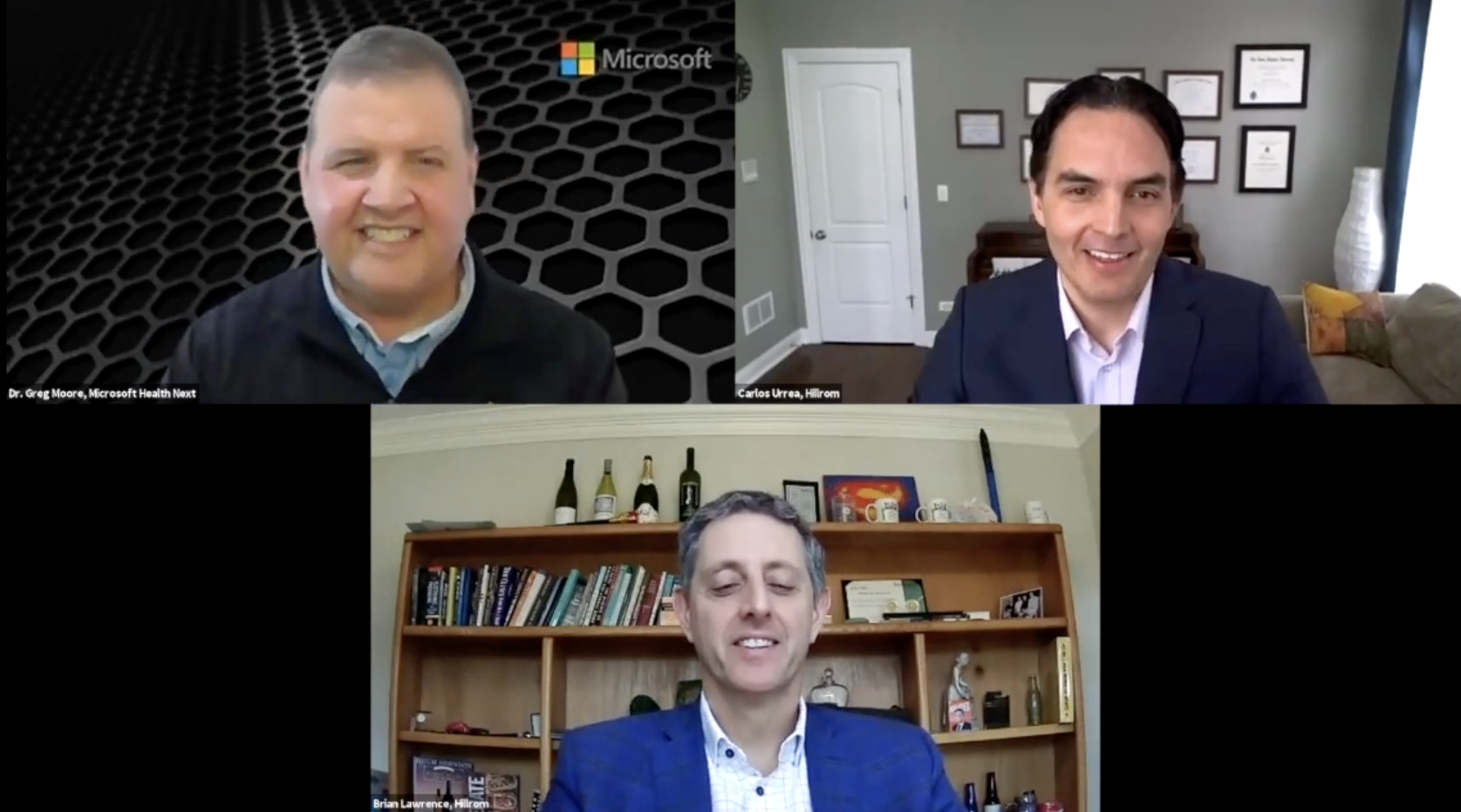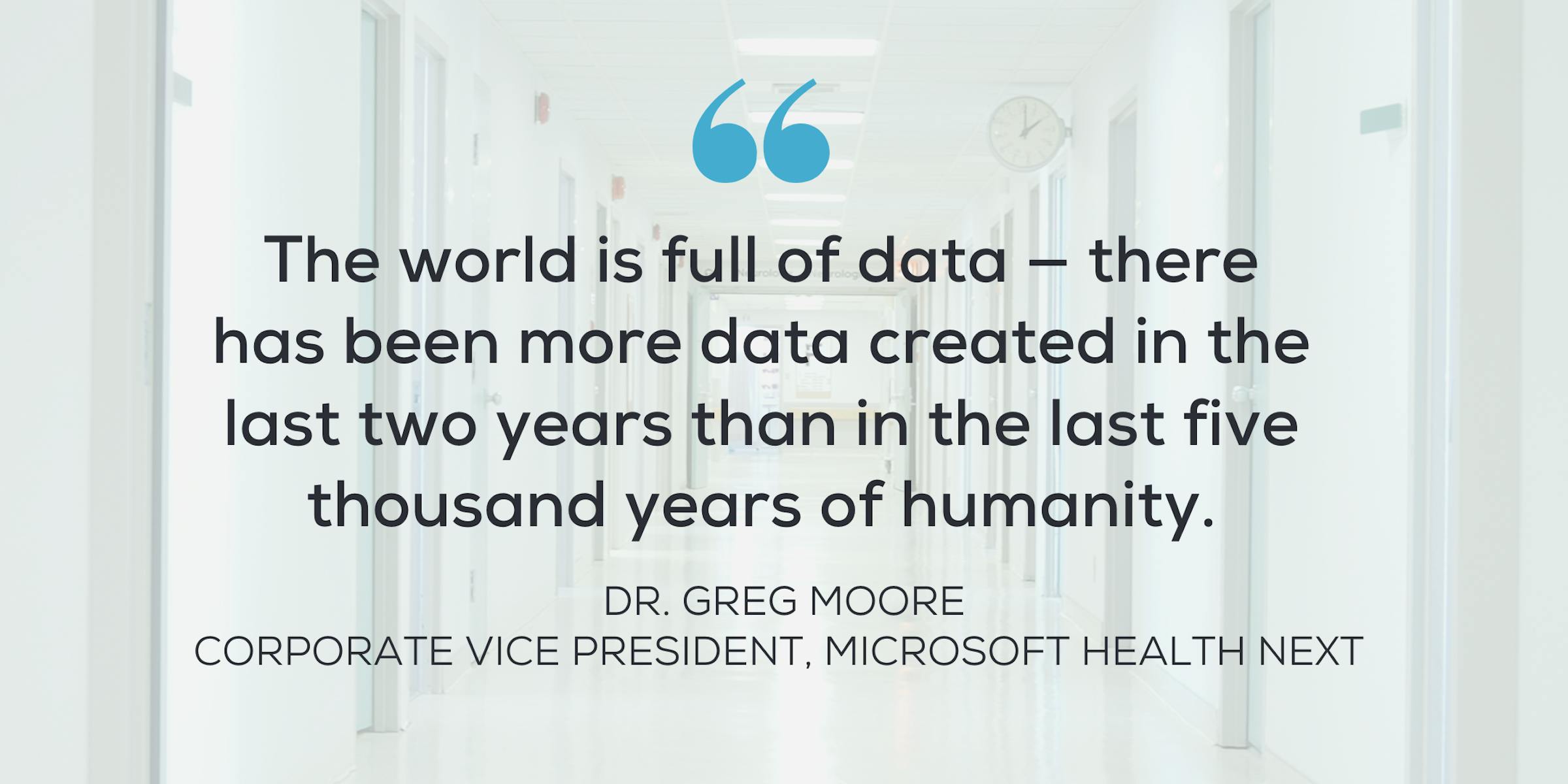Healthcare 2040: How AI will transform clinical decision making
What will healthcare look like in 20 years? What should we invest in today to help us get there?
In 2021, MATTER and Hillrom partnered to produce Healthcare 2040, an event series that invites industry leaders working in significantly transformative areas of healthcare to help us explore these questions.
For the inaugural event, Microsoft Health Next Corporate Vice President Dr. Greg Moore joined us to share his perspectives on how AI-enabled tools will transform clinical decision making over the next 20 years and how these emerging technologies will reshape diagnosis and treatment in the future. Following the keynote, Dr. Moore, Hillrom Senior VP and Chief Technology Officer Brian Lawrence and Hillrom Global VP of Medical Affairs and Informatics Dr. Carlos A. Urrea dove deeper into how clinical decision-making will continue to evolve through leveraging AI.
Watch the full event here.
Following are our key takeaways from the event. Responses have been edited slightly for length and clarity.
The evolution of data in healthcare
Greg: “The world is full of data — there has been more data created in the last two years than in the last five thousand years of humanity. Today, five Exabytes of data are produced in a single day, and by 2025 we are on track to produce more than 70 Zettabytes of data a day. To put that into perspective, we’ll have to innovate novel types of data storage just to begin to think about doing analytics or AI on even a portion of the data that we’ll be producing in 2040. It’s going to be a remarkable time of innovation and acceleration of innovation in this area.
“Healthcare is no different. We’re seeing exponential growth of data, with more than 150 Exabytes of data related to healthcare in the U.S. alone. In my own medical career over the last 25 years, the groundbreaking papers that changed the path of medicine were all centered on hand-extracted data from hundreds of patients with 25,000 data points. It was a landmark breakthrough of its time and changed the face of medicine.
“Between the release of these papers more than 25 years ago and now, we’ve seen a billion fold increase in data use in studies that are typically published in our best journals — from using millions of data points when we found out that critical illness is contagious, to finding out that deep learning actually works in EHR records, to now using the order of trillion of data points to decode the human immune system for detection of disease.
“When we think about sequencing every person or every child born on a planet, a key driver is that there are four billion people on this planet today who do not have meaningful access to healthcare. This gives us an incredible sense of urgency. Of those four billion without access to healthcare, several million of them will come online with high-speed access and connectivity in the next two to four years. Come 2040, the entire population will have access to high-speed internet and that’s going to allow us to deliver both access to care and care in incredible ways.”
Come 2040, the entire population is going to have access to high-speed internet and that’s going to allow us to deliver access to care and deliver care in incredible ways. - Dr. Greg Moore, Microsoft Health Next
Design considerations for technologies to be effective in the AI ecosystem
Brian: “On the one hand, cloud platforms and cloud-based computing have been an incredible boon to the industry in terms of supporting our capability to not only look at these massive amounts of data, but also to apply massive computing power. But as you start to think about some of these IoT applications, you find that balance between what we can currently do in the cloud and what we need to be able to do at the edge with some of the computing capabilities that can become available in the device itself or at the point of care.
“As we think about computing power, expanding access and being able to take advantage of both edge-based computing and cloud computing, we’ve got to be thinking about things like 5G technologies and being more ubiquitous in the ability to move the data around where we need it.
“The other thing that influences our design considerations for artificial intelligence is the breadth of the data that we have access to. There are massive amounts of data being generated, a lot of which are captured in various environments we have today like electronic medical records. As we think about consumer devices, we also have to start to think about the uniqueness of the data that we’re generating and what that uniqueness can start to tell us about what’s happening to the patient. We oftentimes get caught up in a discussion around what is clinically valid or clinically relevant data versus data that isn’t quite as accurate. Over the next two decades as the prevalence of different device sensors expands, we have the ability to triangulate these different data types to the point where we will be able to make clinically accurate diagnoses.
“As much as artificial intelligence can provide, at the end of the day what you’re dealing with is a patient, with human interaction. I cannot stress enough that the success and the successful deployment of these technologies will hinge critically on our change management abilities, in terms of the interface and the engagement on the human side. That’s where we’ve seen a lot of this fall through in the past. Being able to understand how a technology integrates, how it works and how it engages with individuals both on the clinician side and on the patient side will be the linchpin to being able to see broad adoption.”
Greg: “As we think about design considerations, first and foremost we need to think about privacy and security, as we are dealing with some of the most sensitive data that we have in the world — our human health data. We need to build privacy and security foundationally into our technologies. I mention this among other technology pieces because it’s central to what we call health and healthcare. As an industry, we need to always lean into these considerations, not as an afterthought, but in every phase of development.”
The importance of good, interoperable data
Brian: “The ability to look across large collections of data almost demands that we have interoperability. One of the things we’ve done at Hillrom from a device standpoint is develop an infrastructure to support that connectivity, bringing data from our different devices together, and making that data available in relatively standard ways, using HL7 or HL7 FHIR (fast healthcare interoperability resource). So as a customer implements those capabilities and they implement that kind of infrastructure, that data is there and it’s available for use.
“If a customer wants a third-party to come in with an analytics capability, that data becomes available for the third-party to use. It’s really bringing down those barriers and bringing down those hurdles to make that data available. It’s so important to do that, because otherwise the algorithms are only looking at bits and pieces of data, or they’re not able to really look at what they need to from a holistic standpoint.
Greg: “Data needs to flow so that patients and their providers can make the best decisions for them across our entire health and life sciences ecosystem. It’s exciting that we can actually get this data flowing to the benefit of the patients that we all serve. Microsoft Health has been leaning hard into the FHIR effort to enable every organization and every company on the planet to be able to adopt those in a way that’s on platforms.”

Dr. Greg Moore, Dr. Carlos Urrea and Brian Lawrence at the virtual panel event in March
Where will we go to see our doctors in the year 2040?
Greg: “As we look to 2040, I see healthcare being provided in more and differentiated venues than it is today. I think we already see large retailers leaning into healthcare to create access. I’m fascinated by the work that I’m seeing by Walgreens Boots Alliance, CVS and Walmart to create access to care with their endeavors and options.
“I see the ubiquitous use of virtual care, and that’s going to really push the development of remote sensing and diagnostics and the various forums to do this — it’ll push the connectivity. The key technology driver here is identifying how we can bring truth to a virtual encounter and all that it means. We have the senses of sight and voice covered through virtual visits and we can do amazing things with voice and video and maybe impute some additional data points like vitals, but we need to bring a much more holistic view to these encounters. How do we look in the ears of a child in a way that their parent or caregiver is comfortable with? We have to push that technology and make it seamless, connected, without it being a hassle or technology barrier.”
Eliminating bias in AI
Greg: “Bias is a big concern today throughout the field of artificial intelligence. It is necessary to address it now and to lean in. I’m encouraged by what I’m seeing, not only at Microsoft, but elsewhere — full standing committees, internal and external, really leaning in on AI ethics, diversity and inclusivity across datasets.
“Earlier, I talked about the four billion people today without access to healthcare. Fundamentally, we need to include world populations in AI not only to ensure that AI algorithms apply to different populations around the globe, but to actually inform science and medicine. There’s this incredible synergistic effect by being inclusive that gives us better answers, better science and better treatment in medicine without increasing diagnostic odyssey. It’s really important that we work together as humans on this planet. The opportunity here comes with deep responsibility — we will be set back if we don’t pay attention upfront.”
There’s this incredible synergistic effect by being inclusive that gives us better answers, better science and better treatment in medicine without increasing diagnostic odyssey. - Dr. Greg Moore, Microsoft Health Next
Brian: “The way to address bias is to be inclusive. We have to be cognizant of inclusivity — how do we make sure that we are covering the broadest possible demographics so that we’re not increasing an undue bias. We have to be extremely disciplined when we think about the ability to leverage these kinds of great tools and how we build them to be inclusive.
“As you think about the regulatory side, it gets really interesting. In many cases, after a technology is conceived and gets developed, it can take as long as 15 years until it is actually making a difference in healthcare. Some of that has to do with the regulatory challenges that we have. I am really encouraged by some of the work that we are seeing from bodies like the FDA around total lifecycle management, where they recognize that with machine learning algorithms and software development, you’re on a much more rapid cycle of change and innovation. We have to develop regulatory structures to support that. It can’t simply be that every time we make a change to an algorithm because it’s learned something, that we have to go through another entire clearance process. Regulatory bodies are coming to understand that this technology is constantly changing, but we still have a ways to go. I think that’s where we’ll start to see some movement that hopefully starts to shrink that window and allow us to bring technology more quickly into this space in particular.”



